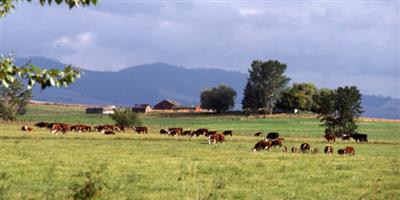by Gary Deering, Vice-President of the South Dakota Stockgrowers Association
The hopeless feeling of looking at the big red slash, showing the market is setting a new low, along with a cup of coffee, seem to be the way cattlemen are used to starting their day. The cattle market has been in a free-fall for some time, devastating balance sheets and putting a crunch on some local economies. With most of the commodities, such as corn, wheat, etc., also at lows, the cattle market was the one bright spot for agriculture a year ago. It will make it hard for anybody in the country to show much, if any profit.
Ft. Pierre LivestocRight-click here to download pictures. To help protect your privacy, Outlook prevented automatic download of this picture from the Internet.k Auction reported in October of 2014 the average 550 pound steer brought $293.50 per hundredweight or $1614.25. A year later the price had dropped to $223.61 per hundredweight, or $1229.86. Seeing an almost $400 (25{e1c719bd29d6bb84a792d8ffcb03a61a093900316f2da3efbd39b86f03d248b8}) drop in cattle prices, an unheard of amount, the South Dakota Stockgrowers joined R-CALF, and others, in calling for Government Accountability Office investigation, to find out what happened to the markets. Unfortunately no alarms were sounded, and the first week in October of 2016 the same 550 pound calf is only bringing $134.42 per hundredweight, or $739.31. Hopefully a $490.55 (40{e1c719bd29d6bb84a792d8ffcb03a61a093900316f2da3efbd39b86f03d248b8}) decrease, from one year to the next ($874.94 less than two years ago) will grab the attention of somebody before this is completely deflated.
It's hard to understand why our agriculture markets have dropped so much when one walks through the aisle at the grocery stores, and sees retail beef prices at four year highs. It is also, probably, the only time in history a bushel of wheat will not buy a loaf of bread! With retailers reaping huge profits off the backs of American farmers and ranchers it shows there is still demand for the commodities we produce.
Exports typically account for approximately 10{e1c719bd29d6bb84a792d8ffcb03a61a093900316f2da3efbd39b86f03d248b8} of total beef produced in the United States. The strong dollar led to a 10{e1c719bd29d6bb84a792d8ffcb03a61a093900316f2da3efbd39b86f03d248b8} drop in exports from 2014 to 2015. That 10{e1c719bd29d6bb84a792d8ffcb03a61a093900316f2da3efbd39b86f03d248b8} drop in exports is only about 1{e1c719bd29d6bb84a792d8ffcb03a61a093900316f2da3efbd39b86f03d248b8} of the beef we produce in this country, showing us that although important, exports are not the sole reason for more than the 50{e1c719bd29d6bb84a792d8ffcb03a61a093900316f2da3efbd39b86f03d248b8} drop in the cattle markets the last two years.
Over the last two years the cattle futures market seems more like a roller coaster than something producers can use to protect their commodities. High speed trading from speculators, who may or may not know what a cow is, make markets volatile, and puts producers who want protect themselves at risk.
Although opposed by the South Dakota Stockgrowers, CME has implemented a seasonal discount on cattle delivered to Worthing, South Dakota to stabilize the futures markets. While that might help, we don't believe it addresses the root cause of the volatility.
In July 2015 USDA announced that we will start importing beef from Brazil. That not only puts our domestic livestock herd at risk of foot and mouth disease, but is a slap in the face of the American cattlemen trying to make a living in this depressed market, with the threat of flooding our markets with Brazil's massive cow herd.
There have been many events within the last two years in which makes it easy to become discouraged. Our markets certainly seem to be broken.
Being comprised of cattlemen South Dakota Stockgrowers grassroots policy and actions are derived solely from the minds that are depending on these markets for their livelihood. Recognizing that our industry is facing a challenge we will pledge to the cattlemen we will do all we can to make sure we fix this mess.
Our record stands strong. South Dakota Stockgrowers have and always will stand for what cattlemen believe in.
We have fought, never wavering, for Country of Origin Labeling, knowing our product is superior, and listening to the wants of some 90{e1c719bd29d6bb84a792d8ffcb03a61a093900316f2da3efbd39b86f03d248b8} of this nation's consumers.
We are always pressing to get the GIPSA rules fully implemented, in order to address anti-competitive practices by packers, and remove unfair bidding activities that give packers a distinct advantage over independent producers.
We also believe we need to enforce our anti-trust laws that would stop the monopolistic behavior, from packers, and retailers, and not allow them to manipulate the prices, be enforced.
The South Dakota Stockgrowers know that we need reform within our livestock markets, and we cannot continue with the current trends in the cattle industry. We must restore confidence in our industry, work to bring about common sense reforms, and bring this free-falling market to its feet again.
Gary Deering is the Vice-President of the South Dakota Stockgrowers Association. He ranches with his wife Jessica and their hree young sons near Hereford, SD.
Photo courtesy of USDA NRCS.


